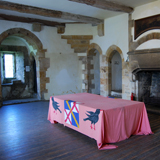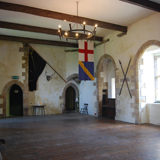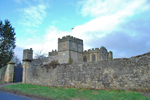History
Bolton Castle is a quadrangular castle with four corner towers surrounded by a high curtain wall. It has an inner courtyard but no central Keep. It is on rising ground overlooking Wensleydale on the edge of the Yorkshire Dales National Park.

A license to crenelate was granted in 1379 to Sir Richard le Scrope, 1st Baron Scrope of Bolton, and Chancellor to King Richard II. By then, construction of the castle had already begun under master mason John Lewyn, who also worked on Raby Castle and Dunstanburgh Castle.
The construction of Bolton Castle was completed in 1399. King Richard II was deposed and murdered, and Sir William Le Scrope was beheaded without trial. In 1405, Archbishop Richard Scrope, son of Lord Scrope of Masham, was executed for his part in Henry "Hotspur" Percy's plot and uprising against Henry IV.
John, 8th Baron Scrope, a supporter of the Pilgrimage of Grace rebellion against Henry VIII's religious reforms, gave the Abbot of Jervaulx sanctuary in Bolton Castle in 1536. Pursued by the King's men, John had to escape to Skipton Castle, but the Abbot was captured and executed. The King ordered that Bolton Castle be set on fire, which caused significant damage. Sir John regained his seat in Parliament, and the castle was repaired within a few years.
In 1568, Mary, Queen of Scots, fled to England after her defeat at the Battle of Langside. Queen Elizabeth of England saw Mary's arrival in England as a threat and took Mary prisoner, initially being held at Carlisle Castle under the watch of Henry, 9th Baron Scrope. Carlisle Castle was deemed unsuitable, so Mary was moved to Bolton Castle in July 1568. She was held prisoner at Bolton for six months. In January 1569, she was transferred to Tutbury Castle in Staffordshire during a heavy snowstorm on orders from Queen Elizabeth, who was concerned that Mary's Jailor, Sir Henry Scrope, might have had designs on the throne by marrying Mary.
In 1644, Parliamentarian forces besieged Bolton Castle for over a year during the Civil War before John Scrope and the garrison defending it finally surrendered on honorable terms after eating all their horses to keep from starving. The castle was slighted to make it untenable in 1647, but much survived, including the Southwest Tower and West curtain wall, complete with private apartments.
In 1675, Bolton Hall was completed, and the family moved out of Bolton Castle. In 1762, the castle's Northeast Tower collapsed.
Bolton Castle remains in the ownership of the descendants of the Scrope family.
Castle Highlights
Bolton Castle is unique in that all four doorways in the inner courtyard have a portcullis. The original entrance to the castle was through a gatehouse in the eastern wing, protected by the Southeast Tower. The gatehouse also had a portcullis at each end.
The castle has many halls and galleries to explore and retains some of its original 600-year-old beams. The most interesting room is the bedchamber where Mary, Queen of Scots, was held prisoner after fleeing to England in 1568. The Solar was a private sitting room used by the family, but also given to Mary, Queen of Scots, along with the bedchamber during her imprisonment.
The Great Hall is also a room of significance, used by successive Lords to entertain in lavish style; the Lord's dinner would consist of two or three courses with wine or ale. The Minstrel's Gallery was located at the east end of the Hall, where doors also lead to the Butteries and the Great Kitchen.
The ground floor contains the Forge and the Armourer's Workshop, which is responsible for all the metalwork that needs to be hammered into shape, like a present-day blacksmith. In the window recess at the far end of the Forge are two doorways leading to the Great Hall and the Armourer's private chamber.
The Chapel was completed around 1395 and is dedicated to St. Anne, Mother of the Virgin Mary. Although ruined now with no roof, the Chapel would have had vast vestments and altar furnishings, with the tall perpendicular windows and their cinquefoil tracery, once glazed. Three priest cells are in the Buttress Tower leading off from the Chapel.
The castle gardens are also fun to explore and contain a hedge maze.
Bolton Castle can be thoroughly explored in 2-4 hours. Middleham Castle is close enough to also visit on the same day. It is not a castle, but close to Bolton Castle is Aysgarth Falls, which is well worth a visit. These picturesque waterfalls were used in the movie "Robin Hood: Prince of Thieves," where Kevin Costner's Robin Hood did a stick battle with Little John while trying to cross the river.
Bolton Castle is also haunted.




